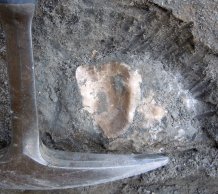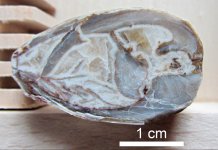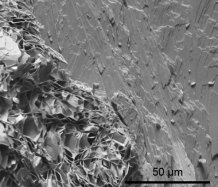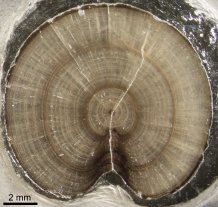
Jurassic ostreoid from the UK. The large shell sizes allows for material-intensive geochemical analyses and growth bands enable studying palaeoseasonality.

Late Triassic brachiopod from New Caledonia; the shell is partly broken and the remaining shell cavity is filled by at least two stages of calcite cement.

SEM photograph of a modern oyster shell (Crassostrea gigas from Sylt, NW Germany) showing two different shell ultrastructures, the so-called chalky layers to the left and the foliate layers to the right. Significant differences in chemical composition are observed for these two types of calcite.

Thick section of a Late Jurassic belemnite rostrum from New Zealand. The banding pattern of the calcite rostrum aids in sampling a well-defined geochemical transect capturing the growth history of the animal.
Macrofossil calcite: a versatile proxy archive
Macrofossil calcite has widely been used as archive of palaeotemperatures through Earth history, reaching back to the latest Precambrian, when shell-building animals first evolved. Such shell material is of considerable importance for understanding past climates and large, fast-growing organisms may even capture seasonal fluctuations in environmental parameters. In particular, proxy data from macrofossil calcite has helped to better constrain the carbon cycle, palaeotemperature and seawater composition of the Palaeozoic and Mesozoic (~541 to ~66 million years ago).
Due to their comparatively large size, macrofossil shells are ideally suited for a series of applications which are currently the focus of research at Camborne School of Mines:
Diagenesis
Sediments undergo a series of processes after their deposition that affect chemical and isotopic composition of its constituents and often it is challenging to unravel, how much a geochemical tracer of interest has suffered from such post-depositional alteration. Macrofossils are usually characterised by a variable preservation state, with parts of the shell well-preserved, parts of the shell partly altered, and shell cavities sometimes filled with diagenetic carbonate cements.
Ongoing research is trying to constrain trends and magnitude of diagenesis in carbonates in a series of sedimentary successions located on different continents. Such information is not only useful for distinguishing altered samples from samples that yield proxy data with palaeoenvironmental significance but can also lead to a more complete understanding of diagenetic processes and their relative timing.
Palaeoseawater composition
Much of the current palaeoenvironmental research is related to constraining past temperatures and carbon cycle dynamics. While these topics are of outstanding importance, macrofossil calcite offers possibilities to understand even more about past environmental conditions.
Marine biogenic calcite also incorporates an imprint of the chemical and isotopic composition of seawater. Studies on modern invertebrates help finding out, how to translate the chemical and isotopic signatures of such calcite into information about the water in which these animals grew. Such information gives critical insights, e.g. whether animals were pushed to preferentially make calcite or aragonite shells (Mg/Ca ratio) and global tectonic processes and weathering intensity (Sr/Ca ratio, 87Sr/86Sr and δ7Li value).
Ongoing research at CSM looks at mapping the chemical composition of modern invertebrate calcite in relation to phylogeny, shell ultrastructure, ontogenetic effects and functional morphology, in order to help constraining robust data about the composition of past seawater and how life and the Earth system coevolved.
Palaeoseasonality
To understand environmental conditions it is not only important to know the annual average of parameters at a given site. Seasonal variability and extreme conditions, e.g. amplitude of temperature change, changes in biotic activity or variability of local salinity give valuable insights as well.
Fossil shell materials that show a growth-related banding pattern are ideal targets for palaeoseasonality studies. In fact, one of the earliest studies on stable isotopes in fossil calcite tried to constrain annual temperature variability. Growth bands in shell materials constitute the backbone for transforming a sequence of geochemical analyses into a time series, and if the growth rate is sufficient, palaeoenvironmental signals can be resolved in high temporal detail (sometimes on the order of a few weeks). Ongoing research at CSM aims at better understanding how biomineralization (e.g., growth rate, biomineral shape) affects the way geochemical proxies are expressed in shell calcite.
- Ullmann, C.V., et al, 2015. Chemical and isotopic architecture of the belemnite rostrum. Geochimica et Cosmochimica Acta 159, 231-243.
- Ullmann, C.V., Korte, C., 2015. Diagenetic alteration in low-Mg calcite from macrofossils: a review. Geological Quarterly 59 (1), 3-20.
- Ullmann, C.V., et al, 2013. Tectonic forcing of Early to Middle Jurassic seawater Sr/Ca. Geology 41 (12), 1211-1214.
- Ullmann, C.V., et al, 2013. The Giant Pacific Oyster (Crassostrea gigas) as a modern analogue for fossil ostreoids: calibration of isotopic (Ca, O, C) and elemental (Mg/Ca, Sr/Ca, Mn/Ca) proxies, Geochemistry, Geophysics, Geosystems 14 (10), 4109-4120.
